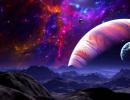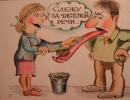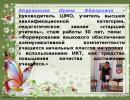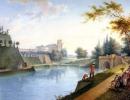Experimental activities in the preparatory group. How to create a rainbow. Lesson summary “Rainbow at home How to make a rainbow from a disk and a flashlight
What could be more beautiful and fantastic than a rainbow? Only a rainbow created with your own hands. The easiest way to make a rainbow is to shine light through a prism. But you don’t always have a prism at hand, and you really want to experiment with a rainbow.
There are several ways to make a rainbow at home using improvised materials, let's look at a few of them.
Rainbow from the disk
This is a very simple way to get a rainbow from an item that is in almost every home today - a CD. The disc will fit any CD\DVD\Blueray, just reflect it sunlight and a beautiful rainbow will play on the white wall.
Rainbow from the water
To do this, you need to shine light through water. For example, you can place a glass of water on the windowsill on a sunny day and the light passing through the water will create a rainbow. If this doesn’t work, you can take a mirror and put it in a glass of water and try to reflect the sunlight with it.
You can also take a flat, shallow container and place a mirror in it at an angle so that one half is above the water and reflect sunlight onto the white surface. The rainbow will appear immediately. The larger the container with water and the mirror, the larger the rainbow.
If the sky is cloudy and the sun is not shining at all, you can make a rainbow using the same methods using a flashlight. But such a rainbow will not be so bright, so you will have to close the curtains tightly and then start experimenting.
Well, if the sun is shining brightly, there is another surefire way to make a rainbow. But for this you will have to go outside and find a hose connected to a water tap. Now all that remains is to pinch the end of the hose so that the water comes out of it as a fine spray, and direct it upward into the sun. A rainbow will sparkle in the splashes of water.
Everyone likes the rainbow - both children and adults. Its colorful tints attract the eye, but its value is not limited to aesthetics alone: it is also a great way to interest a child in science and turn knowledge of the world into exciting game! To do this, we invite parents to conduct several experiments with their children and get a real rainbow right at home.
In Newton's footsteps
In 1672, Isaac Newton proved that the ordinary white color is a mixture of rays of different colors. “I darkened my room,” he wrote, “and made a very small hole in the shutter to let in the sunlight.” In the path of the sun's ray, the scientist placed a special triangular piece of glass - a prism. On the opposite wall he saw a multi-colored strip, which he later called a spectrum. Newton explained this by saying that the prism split white light into its component colors. Then he placed another prism in the path of the multi-colored beam. With this, the scientist reassembled all the colors into one ordinary ray of sunlight.
To repeat the experiment of a scientist, you don’t necessarily need a prism - you can use what you have at hand. In good weather, place a glass of water on a table near a window on the sunny side of the room. Place a sheet of plain paper on the floor near the window so that the sun's rays fall on it. Wet the window with hot water. Then change the position of the glass and the sheet of paper until a small rainbow appears on the paper.
Rainbow from the looking glass
The experiment can also be carried out both in sunny and cloudy weather. To carry it out, you need a shallow bowl of water, a small mirror, a flashlight (if there is no sun outside the window) and a sheet of white paper. Immerse the mirror in water, and position the bowl itself so that the sun's rays fall on it (or point a flashlight at the mirror). If necessary, change the angle of objects. In water, light should refract and break into colors, so that a sheet of white paper can “catch” a small rainbow.
Chemical rainbow
Everyone knows that soap bubbles are rainbow-colored. The thickness of the walls of a soap bubble varies non-uniformly, constantly moving, so its color is constantly changing. For example, at a thickness of 230 nm the bubble turns orange, at 200 nm it turns green, and at 170 nm it turns blue. When, due to water evaporation, the thickness of the wall of a soap bubble becomes less than the wavelength of visible light, the bubble stops shimmering with rainbow colors and becomes almost invisible before bursting - this happens when the wall thickness is approximately 20-30 nm.
The same thing happens with gasoline. This substance does not mix with water, so when it ends up in a puddle on the road, it spreads over its surface and forms a thin film that creates beautiful rainbow stains. We owe this miracle to the so-called interference - or, more simply, the effect of light refraction.
Musical rainbow
Interference causes rainbow tints on the surface of compact discs. This, by the way, is one of the easiest ways to “harvest” rainbows at home. In the absence of sun, a table lamp or a flashlight will do, but in this case the rainbow will be less bright. Simply by changing the angle of the CD, you can get a rainbow stripe, a circular rainbow, and restless rainbow bunnies on a wall or any other surface.
Besides, what is not a good reason to teach your child the basics of musical literacy? After all, Newton initially distinguished only five colors in the rainbow (red, yellow, green, blue and violet), but then he added two more - orange and violet. Thus, the scientist wanted to create a correspondence between the number of colors in the spectrum and the number of notes in the musical scale.
Projector night light
If a temporary solution is not enough for you, you can have a rainbow at home “for real” - for example, using such a miniature projector. It projects a rainbow onto the walls and ceiling - even at night, even on a cloudy day, when invigorating colors are so lacking... The projector can operate in two modes: all colors together, or each separately. On the eve of the New Year holidays, this is perhaps a good gift idea for a child or just a creative person.
Window hanging
Another option for a “rainbow without worries” (which, however, can only be enjoyed during daylight hours, and only in sunny weather) is the so-called rainbow disk, made using modern laser technologies. A glass prism measuring 10 centimeters in diameter is enclosed in a chrome plastic body. It is attached to the window using a suction cup and, transforming sunlight, projects it onto the walls, floor and ceiling of the room. There are 48 color lines in total: red, orange, yellow, green, blue, indigo, purple and everything in between.
Flip book with 3D effect
In the last few years, books with interesting and unusual effects have begun to appear - for example, “flip books” with running pictures. Many of us are familiar with this technology from our own childhood: we drew pictures in the margins of a notebook, and then brought them to life by quickly flipping through the pages. A book based on the principle of this fun was created by Japanese designer Masashi Kawamura. If you quickly flip through it, you can see a voluminous rainbow!
If you wish, you can make a similar handmade rainbow with your own hands, and at the same time clearly demonstrate the animation effect to your child. To do this, you need to print on paper or draw squares of rainbow colors on each page of your notebook. In total you need 30-40 sheets. It is important to take into account that on one side of each page you need to draw them in the usual sequence, and on the other - in the reverse order, otherwise you will not get a rainbow.
Rainbow you can touch
And another fun way to get a rainbow, which will greatly decorate any modern interior, without taking up a centimeter of space and filling it with rainbow radiance. To do this, Mexican designer Gabriel Dawe suggests using skillfully stretched sewing threads. Of course, you will have to tinker with such an installation for an hour or two, but the result is worth it. It is not for nothing that the artist’s works have been a huge success in many countries, including the USA, Belgium, Canada and the UK.
Purpose of the study: to determine what connection exists between rain, sun and the appearance of a rainbow, and whether it is possible to get a rainbow at home. Object of study: natural phenomenon RAINBOW. Subject of research: the origin of the rainbow. Research problem: how to create a rainbow at home; how a rainbow appears and why it is multi-colored; how to create white from colored components.





Every schoolchild can repeat Newton's experiment. I repeated this experiment, but with an artificial light source. We observed the decomposition of light into a spectrum when passing through a prism at home, using a prism and a projector. To do this, we caught a white ray with a prism and got an image of a rainbow on the wall. The light, which seemed white, played on the wall with all the colors of the rainbow. This is how we penetrated the mystery of the ray, which the famous English scientist penetrated more than 300 years ago.

HOW DOES A RAINBOW APPEAR? When it rains, there is a huge amount of water droplets in the air. Each droplet plays the role of a tiny prism, and since there are so many of them, the rainbow turns out to be half the sky. This is who turns out to be building multi-colored gates in the sky quickly and beautifully! Ray of sun and raindrops. All rainbows are sunlight that passes through raindrops, as if through prisms, is refracted and reflected on opposite side sky.




EXPERIENCE “CREATING A RAINBOW AT HOME” To make sure that white color consists of seven colors and a rainbow can be obtained artificially, we conducted an experiment. We needed: a flashlight, a water container, a flat mirror, white cardboard and water. Progress of the experiment: Filled the tray with water. Placed a mirror with an angle. We directed the light of a flashlight onto the part of the mirror immersed in water. To catch the reflected (or refracted) rays, they placed cardboard in front of the mirror.

AS A RESULT, A REFLECTION OF ALL THE COLORS OF THE RAINBOW APPEARED ON THE CARDBOARD, WE WERE ABLE TO GET A RAINBOW AT “HOME” CONDITIONS. Conclusion: a beam of light reflected by a mirror at the exit from the water is refracted. The colors that make up white have different angles of refraction, so they fall at different points and become visible.

EXPERIENCE “HOW TO OBTAIN WHITE COLOR FROM COLOR COMPONENTS?” Just like we decomposed the white color into its components, you can get back the white color from the colored components. If seven colored light sources are placed on one side of the prism at appropriate angles, we will get a white beam at the exit from it.

It is difficult to do such an experiment on your own, but there is another way. If you take a white circle and paint it in the seven colors of the rainbow, and then put this circle on an axis. And start rotating it quickly, in place of the colored circle, we will see white. This occurs due to the inertia of human vision. The eye cannot see each color separately on a rapidly rotating circle, and for it they all merge into one white color.

CONCLUSIONCONCLUSION As a result of the work done, we were convinced that the prism can turn a white beam into a seven-color, rainbow one. They found out that raindrops and ice crystals can divide the white color into seven colors, so you can see a rainbow in autumn, summer, spring, and winter. But there are conditions under which such an amazing natural phenomenon can be seen. We learned about ways to produce a rainbow at home, creating white from colored ingredients.

LITERATURE 1. Belkin I.K. What is a rainbow? – “Quantum” 1984 2. Bulat V. L. Optical phenomena in nature. M.: Education, 1974. 3. Geguzin Y. E. “Who creates the rainbow?” – Quantum 1988 4. Mayer V.V., Mayer R.V. “Artificial rainbow” – Quantum 1988 5. “I explore the world.” Children's encyclopedia. Physics O.G. Hinn - M, LLC 6. Bragin A. About everything in the world. Series: Great Children's Encyclopedia. Publisher: Ast, Children's encyclopedia "I KNOW THE WORLD". AST - LTD" 1998

Anastasia Panfilova
Lesson summary “Rainbow at home”
Rainbow at home.
Purpose of the study: define what it is rainbow how is it formed, and is it possible to obtain rainbow at home.
Research objectives:
1. Find out where it comes from rainbow.
2. Determine what they are rainbows.
3. Try to get rainbow at home.
Progress of the lesson:
1. What is rainbow?
Rainbow- modified word "raiduga", or God's arc.
(According to V. Dahl's dictionary)
Rainbow- a multi-colored arc-shaped stripe on the firmament,
formed due to the refraction of sunlight in raindrops.
(Explanatory dictionary of the Russian language by Ozhegova S.I.)
Both ancient people and ancient scientists tried to unravel the cause of its occurrence. 2. How is it formed? rainbow?
Sunlight appears white to us. But in fact it consists of several colors. It happens that when it rains, the sun comes out, and then the sunlight passes through the water droplets and "disintegrates" for several colors. There are always seven of these colors, and they are arranged in strict order. Red, orange, yellow, green, blue, indigo, violet. So it turns out multi-colored rainbow. An object that can split a ray of light into its components is called "prism". The resulting colors create a strip of colored lines called "range". Rainbow and there is a large spectrum, or band of colored lines, resulting from the decay of a ray of light passing through raindrops. IN in this case raindrops act as a prism.
Rainbow appears, only when the sun peeked out from behind the clouds and only in the direction opposite to the sun.
Rainbow appears when the sun illuminates the curtain of rain. You need to be strictly between the sun (it should be at the back) and rain (he should be in front of you). Otherwise can't see the rainbow!
The sun, our eyes and center rainbows must be on the same line! If the sun is high in the sky, then it is impossible to draw such a straight line. That's why rainbow can only be observed early in the morning or late in the evening. Rainbow appears under condition that the angular height of the sun above the horizon does not exceed 42 degrees.
Does it happen? rainbow without rain?
It turns out that such a miracle also happens. In the air in winter "float" ice crystals. They can also divide white into seven colors rainbows, That's why rainbow can be observed even in winter.
How to do rainbow at home?
Experiment No. 1.
Target: receiving rainbows at home using a CD.
Equipment: CD, light source - sunbeam.
Description of the experiment: A computer disk caught a ray of sunlight and directed it to the wall and ceiling of the room. It turned out rainbow.
Experiment No. 2.
Target: receiving rainbows at home using napkins, water and markers.
Equipment: a plate of water, napkins and markers.
Draw circles on a napkin using felt-tip pens of different colors. Pour enough water into the plate to cover the bottom. Place a napkin in the water and watch the miracle!
Experiment No. 3.
Target: receiving rainbows at home with candy and water.
Equipment: plate, water, MMDEMS
Put the candies in the circle in order rainbow colors, pour plain water into the middle of the plate and enjoy the process. After a few seconds, the child clearly understands what the dye is.
Experiment No. 4.
Target: receiving rainbows at home using a mirror and a flashlight.
Equipment: a plate filled with water, white cardboard, a mirror, a light source - a flashlight.
Description of the experiment: We took a plate, filled it with water, and lowered the mirror at an angle. Then they directed the light of the flashlight onto the part of the mirror immersed in water. When we placed white cardboard in front of a mirror to catch the reflected rays, we saw a reflection on the cardboard rainbows.






